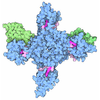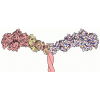+ Open data
Open data
- Basic information
Basic information
| Entry | Database: PDB / ID: 9iti | ||||||
|---|---|---|---|---|---|---|---|
| Title | Nav1.7 with mutations that eliminate beta1 binding | ||||||
 Components Components | Sodium channel protein type 9 subunit alpha | ||||||
 Keywords Keywords | MEMBRANE PROTEIN / Voltage-gated sodium channel | ||||||
| Function / homology |  Function and homology information Function and homology informationaction potential propagation / detection of mechanical stimulus involved in sensory perception / cardiac muscle cell action potential involved in contraction / node of Ranvier / voltage-gated sodium channel complex / Interaction between L1 and Ankyrins / voltage-gated sodium channel activity / Phase 0 - rapid depolarisation / detection of temperature stimulus involved in sensory perception of pain / behavioral response to pain ...action potential propagation / detection of mechanical stimulus involved in sensory perception / cardiac muscle cell action potential involved in contraction / node of Ranvier / voltage-gated sodium channel complex / Interaction between L1 and Ankyrins / voltage-gated sodium channel activity / Phase 0 - rapid depolarisation / detection of temperature stimulus involved in sensory perception of pain / behavioral response to pain / neuronal action potential / axon terminus / sensory perception of pain / sodium ion transmembrane transport / post-embryonic development / circadian rhythm / response to toxic substance / Sensory perception of sweet, bitter, and umami (glutamate) taste / inflammatory response / axon / plasma membrane Similarity search - Function | ||||||
| Biological species |  Homo sapiens (human) Homo sapiens (human) | ||||||
| Method | ELECTRON MICROSCOPY / single particle reconstruction / cryo EM / Resolution: 2.92 Å | ||||||
 Authors Authors | Yan, N. / Li, Z. / Wu, T. | ||||||
| Funding support |  China, 1items China, 1items
| ||||||
 Citation Citation |  Journal: Proc Natl Acad Sci U S A / Year: 2025 Journal: Proc Natl Acad Sci U S A / Year: 2025Title: Critical role of extracellular loops in differential modulations of TTX-sensitive and TTX-resistant Na channels. Authors: Tong Wu / Xinyu Yang / Xueqin Jin / Nieng Yan / Zhangqiang Li /  Abstract: The cardiac voltage-gated sodium channel Na1.5 is resistant to tetrodotoxin (TTXr). Here, we report a cryo-electron microscopy (cryo-EM) structure of wild-type human Na1.5, coexpressed with the β1 ...The cardiac voltage-gated sodium channel Na1.5 is resistant to tetrodotoxin (TTXr). Here, we report a cryo-electron microscopy (cryo-EM) structure of wild-type human Na1.5, coexpressed with the β1 auxiliary subunit and treated with high-concentration TTX, at 3.4 Å resolution. Structural comparison reveals the molecular determinants for the distinct responses to TTX as well as β subunits between TTXr and TTX-sensitive (TTXs) Na channels. A conserved cation-π interaction between the guanidinium group of TTX and Tyr or Phe on the P2 helix in TTXs Na channels is lost in all TTXr subtypes owing to the replacement by Cys/Ser at the corresponding locus, explaining their differential TTX sensitivities. The β1 subunit is invisible in the EM map. Comparison of Na1.5 with Na1.7 and Na1.8, which are, respectively, TTXs and TTXr, identifies four sites on the extracellular loops (ECLs) that may account for their different β1-binding abilities. When the corresponding residues in TTXs Na1.7 are replaced with those from Na1.5, the modulatory effects of β1 on channel activation and inactivation are diminished. Consistently, β1 is absent in the 3D EM reconstruction of this Na1.7 mutant. Together with our previous structure-guided discovery that TTXr channels lack a Cys on the ECL for disulfide bond formation with β2 or β4, the structure-function relationship studies underscore the importance of the ECLs in the mechanistic distinctions between TTXs and TTXr Na channels. The ECLs may be further explored for the development of subtype-specific drugs. | ||||||
| History |
|
- Structure visualization
Structure visualization
| Structure viewer | Molecule:  Molmil Molmil Jmol/JSmol Jmol/JSmol |
|---|
- Downloads & links
Downloads & links
- Download
Download
| PDBx/mmCIF format |  9iti.cif.gz 9iti.cif.gz | 283.4 KB | Display |  PDBx/mmCIF format PDBx/mmCIF format |
|---|---|---|---|---|
| PDB format |  pdb9iti.ent.gz pdb9iti.ent.gz | 210.3 KB | Display |  PDB format PDB format |
| PDBx/mmJSON format |  9iti.json.gz 9iti.json.gz | Tree view |  PDBx/mmJSON format PDBx/mmJSON format | |
| Others |  Other downloads Other downloads |
-Validation report
| Summary document |  9iti_validation.pdf.gz 9iti_validation.pdf.gz | 2.4 MB | Display |  wwPDB validaton report wwPDB validaton report |
|---|---|---|---|---|
| Full document |  9iti_full_validation.pdf.gz 9iti_full_validation.pdf.gz | 2.4 MB | Display | |
| Data in XML |  9iti_validation.xml.gz 9iti_validation.xml.gz | 55.2 KB | Display | |
| Data in CIF |  9iti_validation.cif.gz 9iti_validation.cif.gz | 80.4 KB | Display | |
| Arichive directory |  https://data.pdbj.org/pub/pdb/validation_reports/it/9iti https://data.pdbj.org/pub/pdb/validation_reports/it/9iti ftp://data.pdbj.org/pub/pdb/validation_reports/it/9iti ftp://data.pdbj.org/pub/pdb/validation_reports/it/9iti | HTTPS FTP |
-Related structure data
| Related structure data |  60867MC  9ithC M: map data used to model this data C: citing same article ( |
|---|---|
| Similar structure data | Similarity search - Function & homology  F&H Search F&H Search |
- Links
Links
- Assembly
Assembly
| Deposited unit | 
|
|---|---|
| 1 |
|
- Components
Components
-Protein , 1 types, 1 molecules A
| #1: Protein | Mass: 231137.781 Da / Num. of mol.: 1 Source method: isolated from a genetically manipulated source Source: (gene. exp.)  Homo sapiens (human) / Gene: SCN9A, NENA / Production host: Homo sapiens (human) / Gene: SCN9A, NENA / Production host:  Homo sapiens (human) / References: UniProt: Q15858 Homo sapiens (human) / References: UniProt: Q15858 |
|---|
-Sugars , 2 types, 4 molecules 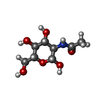
| #2: Polysaccharide | Source method: isolated from a genetically manipulated source #3: Sugar | |
|---|
-Non-polymers , 7 types, 24 molecules 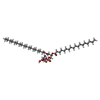



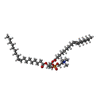
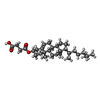
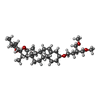






| #4: Chemical | | #5: Chemical | ChemComp-NA / | #6: Chemical | ChemComp-LPE / #7: Chemical | ChemComp-1PW / ( | #8: Chemical | ChemComp-PCW / #9: Chemical | ChemComp-Y01 / #10: Chemical | ChemComp-9Z9 / ( | |
|---|
-Details
| Has ligand of interest | N |
|---|---|
| Has protein modification | Y |
-Experimental details
-Experiment
| Experiment | Method: ELECTRON MICROSCOPY |
|---|---|
| EM experiment | Aggregation state: PARTICLE / 3D reconstruction method: single particle reconstruction |
- Sample preparation
Sample preparation
| Component | Name: Nav1.7 with mutations that eliminate beta1 binding / Type: COMPLEX / Entity ID: #1 / Source: RECOMBINANT |
|---|---|
| Molecular weight | Experimental value: NO |
| Source (natural) | Organism:  Homo sapiens (human) Homo sapiens (human) |
| Source (recombinant) | Organism:  Homo sapiens (human) Homo sapiens (human) |
| Buffer solution | pH: 7.5 |
| Specimen | Embedding applied: NO / Shadowing applied: NO / Staining applied: NO / Vitrification applied: YES |
| Vitrification | Cryogen name: ETHANE |
- Electron microscopy imaging
Electron microscopy imaging
| Experimental equipment |  Model: Titan Krios / Image courtesy: FEI Company |
|---|---|
| Microscopy | Model: FEI TITAN KRIOS |
| Electron gun | Electron source:  FIELD EMISSION GUN / Accelerating voltage: 300 kV / Illumination mode: FLOOD BEAM FIELD EMISSION GUN / Accelerating voltage: 300 kV / Illumination mode: FLOOD BEAM |
| Electron lens | Mode: BRIGHT FIELD / Nominal defocus max: 1800 nm / Nominal defocus min: 1300 nm |
| Image recording | Electron dose: 50 e/Å2 / Film or detector model: GATAN K3 (6k x 4k) |
- Processing
Processing
| EM software | Name: PHENIX / Version: 1.18_3855: / Category: model refinement | ||||||||||||||||||||||||
|---|---|---|---|---|---|---|---|---|---|---|---|---|---|---|---|---|---|---|---|---|---|---|---|---|---|
| CTF correction | Type: PHASE FLIPPING AND AMPLITUDE CORRECTION | ||||||||||||||||||||||||
| 3D reconstruction | Resolution: 2.92 Å / Resolution method: FSC 0.143 CUT-OFF / Num. of particles: 193309 / Symmetry type: POINT | ||||||||||||||||||||||||
| Refine LS restraints |
|
 Movie
Movie Controller
Controller





 PDBj
PDBj